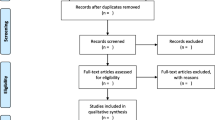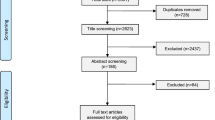Abstract
Objective
Moxibustion is currently used for treating diabetes mellitus (DM) as a non-drug intervention in East Asian countries. This systematic review aims to evaluate the effectiveness of moxibustion for managing the symptoms of type 2 DM patients.
Methods
We searched MEDLINE, AMED, EMBASE, CINAHL, The Cochrane Library, six Korean databases, and four Chinese databases. Risk of bias was used for evaluating the quality of the included studies.
Results
A total of 5 studies met the inclusion criteria for this review. All of the included studies had high risks of bias. One randomized clinical trial (RCT) compared the effectiveness of one-time moxibustion use with oral administration of glibenclimide and showed the significant effects of moxibustion on glycemic control. Another RCT tested the effectiveness of moxibustion plus conventional treatment, and the moxibustion group reported significant improvement in fasting and postprandial blood glucose levels compared with the conventional treatment group. Two RCTs compared the effectiveness of moxibustion versus acupuncture or moxibustion plus acupuncture, and the combined treatment showed the most favorable effects on the control of blood glucose, urine glucose, and glycocylated hemoglobin A1c (HbA1c). One uncontrolled observational study showed favorable effects of moxibustion on the response rate.
Conclusions
It is difficult to conclude that moxibustion is an effective intervention for the control of type 2 DM due to the scarcity of trials and the low methodological quality of included studies. Further rigorous RCTs may be necessary to evaluate the effectiveness of moxibustion for type 2 DM.
Similar content being viewed by others
References
Srinivasan B, Taub N, Khunti K, Davies M. Diabetes: glycaemic control in type 2. Clin Evid (Online) 2008;2008. pii:0609.
Pagan JA, Tanguma J. Health care affordability and complementary and alternative medicine utilization by adults with diabetes. Diabetes Care 2007;30:2030–2031.
Chang HY, Wallis M, Tiralongo E. Use of complementary and alternative medicine among people with type 2 diabetes in Taiwan: a cross-sectional survey. Evid Based Complement Alternat Med 2011;2011.pii: 983792.
Tackett KL, Jones MC. Complementary and alternative medicines for the treatment of diabetes. J Pharm Prac 2009;22:546–552.
Liu JP, Zhang M, Wang W, Grimsgaard S. Chinese herbal medicines for type 2 diabetes mellitus. Cochrane Database Syst Rev 2004;3:CD003642.
Dham S, Shah V, Hirsch S, Banerji MA. The role of complementary and alternative medicine in diabetes. Curr Diab Rep 2006;6:251–258.
Choi TY, Kim TH, Kang JW, Lee MS, Ernst E. Moxibustion for rheumatic conditions: a systematic review and meta-analysis. Clin Rheumatol 2011; Epub 2011 Feb 18. Available from: URL: http://www.springerlink.com/content/4v436pl80158000n/
Higgins J, Altman D. Assessing risk of bias in included studies. In: Higgins J, Green S, eds. Cochrane handbook for systematic reviews of interventions. Chichester (UK): John Wiley & Sons; 2008;187–241.
Park JE, Lee MS, Choi SM. Is it possible to blind subjects using sham moxibustion treatment? Am J Chin Med 2009;37:407–409.
Gong J. Clinical observation on moxibustion treatment for type 2 diabetes of 275 cases. Jilin J Tradit Chin Med (Chin) 2008;28:593.
Wang CP, Li XG, Li YC. Affect of moxibustion steam umbilical artery of diabetic patients with vascular lesions of carotid. Beijing J Tradit Chin Med (Chin) 2009;28:547–548.
Cao SM. Comparative study of acupuncture, moxibustion and acupuncture plus moxibustion in treatment of diabetes. Chin Acupunct Moxibust (Chin) 1997;10:586–587.
Liao H, Xi P, Chen Q, Yi L, Zhang Y. Clinical study on acupuncture, moxibustion, acupuncture plus moxibustion at weiwanxiashu (EX-B3) for treatment of diabetes. Chin Acupunct Moxibust (Chin) 2007;27:482–484.
Han BQ, Zheng WY, Wei F. Herbal cake separated moxibustion for treatment of 34 patients with early diabetes. J Extern Ther Tradit Chin Med (Chin) 2008;17:55.
Ewins DL, Bakker K, Young MJ, Boulton AJ. Alternative medicine: potential dangers for the diabetic foot. Diabet Med 1993;10:980–982.
Reinhart MA, Ruhs H. Moxibustion: another traumatic folk remedy. Clin Pediatr 1985;24:58–59.
Lyu BS, Matsumoto T. Moxibustion warning. JAMA 1974;230:1385–1386.
Conde-Salazar L, Gonzalez MA, Guimarens D, Fuente C. Burns due to moxibustion. Contact Dermatitis 1991;25:332–333.
Chau N. Moxibustion burns. J Hosp Med 2006;1:367.
Shen BQ, Xue YJ, Shi FX, Zhu XP, Sun ZH, Jie SG, et al. Experimental study for evaluating the effectiveness of smokless moxibustion in non-insulin-dependent diabetes mellitus (NIDDM) rats. J Clin Acupunct Moxibust (Chin) 2000;11:43–46.
Qing F, Tan HR, Pan JQ. Advances of research on acu-moxibustion treatment for experimental diabetes mellitus and other endocrinous metabolism-associated diseases. Acupunct Res 2004;29:299–309.
Schulz KF, Altman DG, Moher D, for the CONSORT Group. Consort 2010 statement: updated guidelines for reporting parallel group randomised trials. Trials 2010;11:32.
MacPherson H, Altman DG, Hammerschlag R, Li Y, Wu T, White A, et al. Revised standards for reporting interventions in clinical trials of acupuncture (STRICTA): extending the consort statement. Acupunct Med 2010;28:83–93.
Author information
Authors and Affiliations
Corresponding author
Rights and permissions
About this article
Cite this article
Kim, TH., Choi, TY., Shin, BC. et al. Moxibustion for managing type 2 diabetes mellitus: A systematic review. Chin. J. Integr. Med. 17, 575–579 (2011). https://doi.org/10.1007/s11655-011-0811-2
Received:
Published:
Issue Date:
DOI: https://doi.org/10.1007/s11655-011-0811-2




